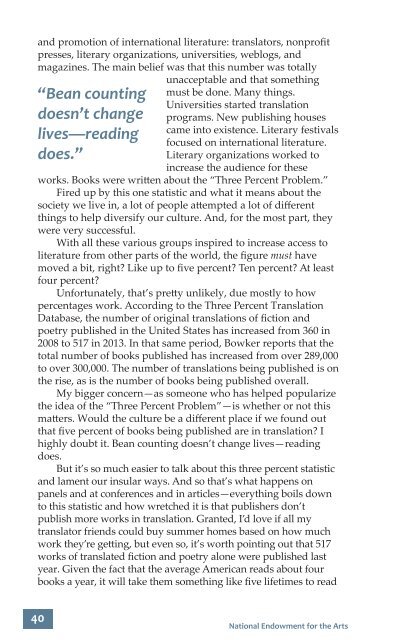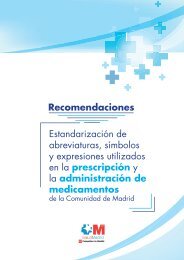lKd7nD
lKd7nD
lKd7nD
Create successful ePaper yourself
Turn your PDF publications into a flip-book with our unique Google optimized e-Paper software.
and promotion of international literature: translators, nonprofit<br />
presses, literary organizations, universities, weblogs, and<br />
magazines. The main belief was that this number was totally<br />
unacceptable and that something<br />
“Bean counting<br />
doesn’t change<br />
lives—reading<br />
does.”<br />
must be done. Many things.<br />
Universities started translation<br />
programs. New publishing houses<br />
came into existence. Literary festivals<br />
focused on international literature.<br />
Literary organizations worked to<br />
increase the audience for these<br />
works. Books were written about the “Three Percent Problem.”<br />
Fired up by this one statistic and what it means about the<br />
society we live in, a lot of people attempted a lot of different<br />
things to help diversify our culture. And, for the most part, they<br />
were very successful.<br />
With all these various groups inspired to increase access to<br />
literature from other parts of the world, the figure must have<br />
moved a bit, right Like up to five percent Ten percent At least<br />
four percent<br />
Unfortunately, that’s pretty unlikely, due mostly to how<br />
percentages work. According to the Three Percent Translation<br />
Database, the number of original translations of fiction and<br />
poetry published in the United States has increased from 360 in<br />
2008 to 517 in 2013. In that same period, Bowker reports that the<br />
total number of books published has increased from over 289,000<br />
to over 300,000. The number of translations being published is on<br />
the rise, as is the number of books being published overall.<br />
My bigger concern—as someone who has helped popularize<br />
the idea of the “Three Percent Problem”—is whether or not this<br />
matters. Would the culture be a different place if we found out<br />
that five percent of books being published are in translation I<br />
highly doubt it. Bean counting doesn’t change lives—reading<br />
does.<br />
But it’s so much easier to talk about this three percent statistic<br />
and lament our insular ways. And so that’s what happens on<br />
panels and at conferences and in articles—everything boils down<br />
to this statistic and how wretched it is that publishers don’t<br />
publish more works in translation. Granted, I’d love if all my<br />
translator friends could buy summer homes based on how much<br />
work they’re getting, but even so, it’s worth pointing out that 517<br />
works of translated fiction and poetry alone were published last<br />
year. Given the fact that the average American reads about four<br />
books a year, it will take them something like five lifetimes to read<br />
40<br />
National Endowment for the Arts



